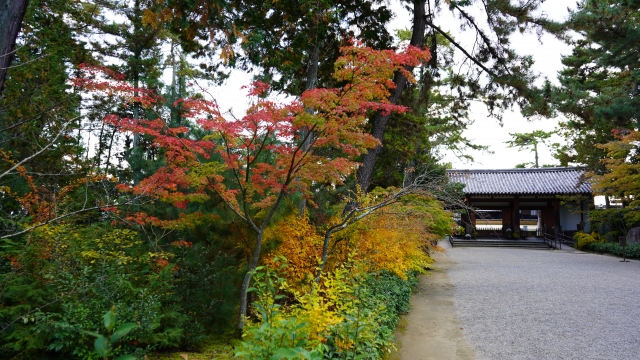About Toshoudaiji temple
Toshoudaiji temple is located in the west of Nara, adjacent to Yakushi Temple. Time constraints, of course, choose the temple.
In front of the tomb, I felt the talent of Kanzen to promote the Dharma, the courage and perseverance of the six crossings, and the hardship of preaching, which has blossomed over the millennium and has been praised by future generations. +
Emperors and generals, the power of the hefty, enjoy all the honor and glory during their lifetime. However, how many people can compare with a monk in terms of merit after death?

Fare
Adults 600 yen; high school and junior high school students 400 yen; elementary school students 200 yen;
Gokyo-do 500 yen for adults; 300 yen for high school and junior high school students; 200 yen for elementary school students;
Shinbouzou 200 yen for adults; 100 yen for high school, junior high school and elementary school students
How to get there
Take a bus bound for “Rokujozan-yuki” and get off at “Tangchoutiji Temple” stop;
Or walk 700 meters from the Kintetsu Nishikyo Station Exit, which takes about 10 minutes.
Tips
It was highly recommended by my colleague before this trip.
Although the place is not as “only single-digit visitors in the whole temple” as my colleague said after more than a year, it is still a pleasant surprise.
This is the temple built by the hands of the monk Kanzen, and is also the place where he passed away. Although as an illiterate do not understand the meaning of more, but also have little religious beliefs, but walking in such a well-preserved thousands of years in the temple, but still will feel quiet and calm.
The temple is far away from the city, so I took a cab directly from Nara Park to this place, and there was basically no chance to get a cab on the way back. So I followed the Google map to take the Kintetsu, but I was able to enjoy the Japanese countryside by mistake.
Toshoudaiji temple, a symbol of Sino-Japanese friendship, was built in 770 under the auspices of the great monk Jyozen. It is the tomb of the great monk Gyanjin and the head temple of the Japanese Ritsu sect. First of all, the temple is also the site of a haiku written by a famous haiku poet in the Edo period. It is called “Wakaba shizuku no shizuku (nugu) habaya”. It means “Wipe the dew from the blind eyes of Gyanjin-sama with a young leaf (Gyanjin-sama’s eyes are visible like dew because of his blindness).”
The first stop in Nara Nishinokyo is to visit the Toshoudaiji temple, which is a symbol of Sino-Japanese friendship and the center of Japanese Buddhist rituals. The Golden Hall and the Lecture Hall, both dating from the 8th century (the second half of the 8th century), are indeed older than most ancient Chinese buildings and are a rare world cultural heritage site, historically speaking, the second half of the 8th century was a critical period in the history of the Tang dynasty when the dynasty was in decline from its prosperity, and after the devastation of the An Shi Rebellion, the Tang dynasty experienced the invasion of the Tubo, losing most of its territory, such as the Ansi and Beitei capitals.
The Tang Dynasty lost most of its territories, such as the Ansi Prefecture and the Beiting Prefecture, and the sixteen states of Youyun fell into a situation of vassalage. Japan at this time was in the latter part of the Nara period, when it had absorbed various advanced cultures from the mainland and its legal system was gradually stabilizing. There is no need to repeat the story of the eastern journey of Jin-jin. Here is a brief overview of the main acts of Jin-jin after his stay in Japan. After the confrontation between the native Japanese Buddhism and the Chinese Ritsu sect of Jyozen, after Jyozen conceded that “self-vowed precepts” could still exist, the native Japanese sect of Heifukuji was convinced and 500 members of the imperial family and ministers, including the Empress Dowager Seibu, took Jyozen’s precepts, and Jyozen assumed the post of “Grand Priest of He assumed the position of “Grand Priest. Thus, in 756, Japanese Buddhism had a formal system of precepts under the leadership of Gyanzen.
However, the position of Gyanjin was weakened after Emperor Takahim was forced to pass the throne to Emperor Chunin, and since Gyanjin’s supporters had lost their power, his position as “Grand Priest” was dismissed on the grounds that he was “troubled by political affairs and did not dare to labor in his old age. Gyanjin was forced to leave Todaiji Temple and moved to the former residence of the former prince, King Dojo (who had been defeated in the court struggle). His disciples drafted a temple, and Emperor Chunin gave it the name “Tangchoutiji Temple”. As we said, the temple was built in about 770, and the monk passed away in 763. Therefore, it is likely that the great monk Jianzhen did not see the completion of Tang Zoti Temple, and although this regret remains, the disciples have kept the statue of Master Jianzhen in the hall for a long time as a memorial to the late master.
